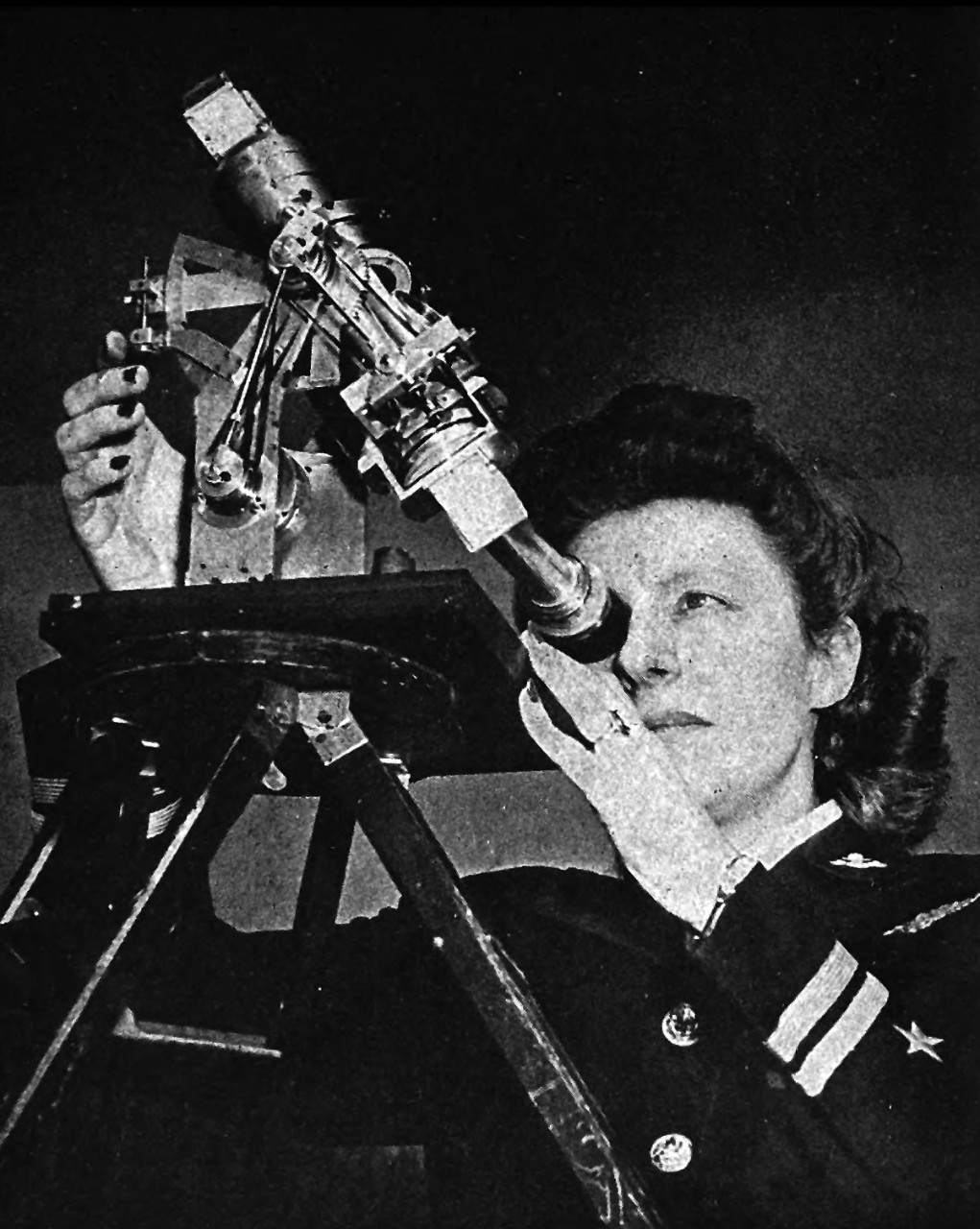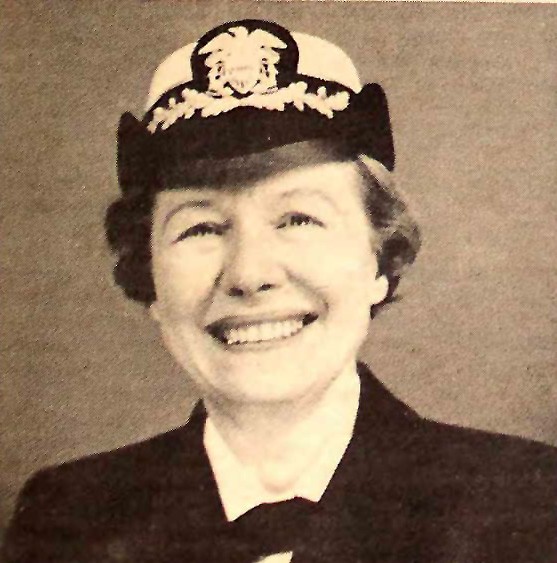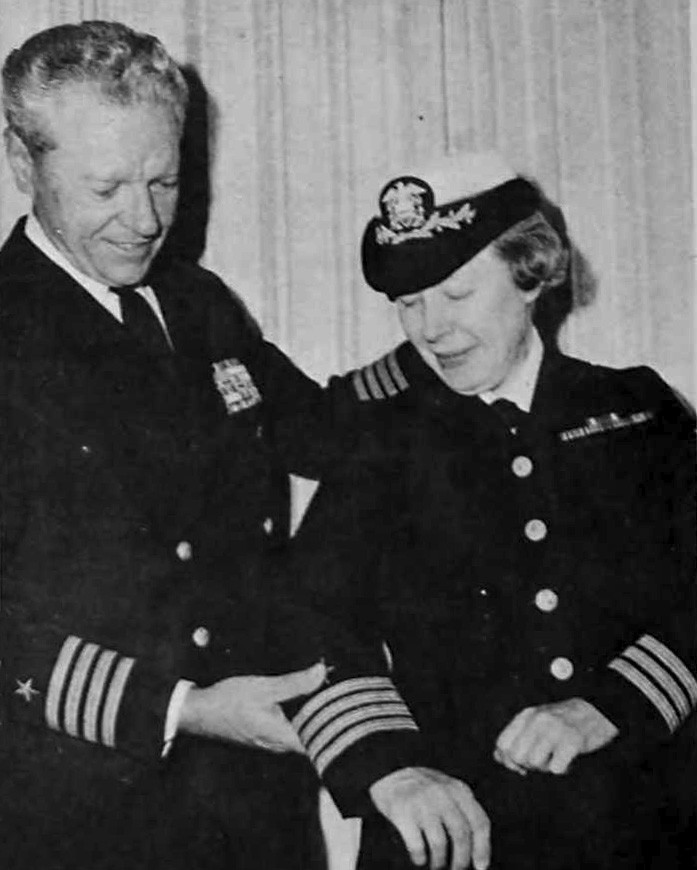Captain Frances E. Biadasz
(1914–1967)

Lieutenant Frances Biadasz looking through a new aircraft sextant, c. 1946. (Image extracted from Bureau of Naval Personnel, All Hands, no. 356 [Oct 1946]: 39)
On 21 April 1914, Frances Elizabeth Biadasz was born in Webster, Massachusetts, to John and Julia Biadasz, both naturalized citizens who had emigrated from Poland. In 1935, she graduated with a bachelor’s degree in mathematics and French from Worcester State Teachers’ College. She returned to her hometown as a high school math teacher. However, she also had dreams of becoming a journalist and worked evenings at the local newspaper.1 Seven years later, her goals shifted as did those of many when war shook the country.
During World War II, the need for additional military personnel inspired the creation of the Navy WAVES (Women Accepted for Volunteer Emergency Service). Biadasz was among the first women to sign up in September 1942.2 She became a member of the first class of officer candidates at Smith College.
Because of her experience in journalism, she was first assigned as a communications officer at the Philadelphia Naval Shipyard. Shortly after, she applied to a program in air navigation. Based on her college education in mathematics, she was accepted. The first WAVES reported to the Naval Air Navigation School (NANS) in Hollywood, Florida, in the summer of 1943.3
WAVES accepted to NANS were intended to replace male navigators assigned to sea duty and to serve as instructors for male cadets. Ensign Biadasz and her classmates received Naval Aviation Observer Wings upon graduation from this program.4 They were the first women to wear this qualification insignia.
Starting in June 1943, Free French pilots came to the United States as part of the Centres de Formation du Personnel Navigant en Amérique (Training Centers of Flight Personnel in America) to learn how to fly American planes before returning to Europe to fight. The U.S. Navy needed instructors who could teach in French. Once again, Biadasz received a new assignment because her college education. She was selected as an instructor and a liaison officer for the Free French pilots.
In March 1944, the naval air navigation school was transferred to Shawnee, Oklahoma.5 The program was so useful to fleet operations that the Navy subsequently authorized its expansion and transferred the program to Clinton, Oklahoma.6 Biadasz was promoted to lieutenant in August 1945, one month before the war came to an end. In 1946, only a small number of WAVES were retained by the Navy to assist with demobilization, with the rest discharged from service.
This war changed how many women who served looked at their future.7 Biadasz had originally intended to leave the Navy after the war and return to her career as a journalist, but she decided to stay in the service. She later said that she soon realized “how much this country needed people who had more than a casual knowledge of international affairs and the role this country had to play in the atomic age.”8
After the passage of the Women’s Armed Services Integration Act in 1948, Biadasz was among those in the Naval Reserve who requested a transfer to the regular Navy. She became one of the first 288 women commissioned. In 1948, she reported to the aviation division of the Navy’s Office of Information. One of her first major assignments was the 1949 commemorative flight of the Truculent Turtle, a modified P2V-1 Neptune maritime patrol aircraft that made a record-breaking endurance flight in September 1946. The Turtle flew nonstop 11,235 miles from Perth, Australia to Columbus, Ohio.
Biadasz understood the value of education from her wartime experience. Expanding opportunities for women to continue their graduate education inspired her. While serving in Washington, Biadasz started taking evening classes at the Edmund A. Walsh School of Foreign Service at Georgetown University.9 She specialized in Russian history and Communist philosophy and strategy. Already able to speak Polish and French, she acquired Russian, which allowed her to study primary sources associated with her studies. After completing her coursework for her degree, Biadasz was selected as the district director of the WAVES of the First Naval District (New England) in 1951. She continued working on her thesis while based in Boston.10
In February 1952, she was promoted to lieutenant commander.11 The following year, she completed her thesis and earned her master’s degree in international relations.12
From 1954 to 1958, she was assigned to the Office of the Chief of Naval Operations (OPNAV) in Washington. She was originally tasked with personnel planning before being selected as special assistant to Chief of Naval Operations (CNO) Admiral Arleigh A. Burke. During this period, she earn was promoted to commander.13 She continued to attend evening classes to earn her doctorate. Burke was supportive of her graduate education and the Navy granted her a year to complete her comprehensive examinations for her doctoral degree. However, she transferred to her next assignment before the end of her year.
In 1959, she was assigned to the North Atlantic Treaty Organization (NATO)’s Advisory Group on Aeronautical Research and Development (AGARD) in Paris, France. She spent a year as a special assistant for international public relations to the group’s chairman and renowned scientist, Dr. Theodore Von Kármán.14
After her return from Europe, Commander Biadasz presented her dissertation on “Defense Reorganization During the Eisenhower Administration” and received her doctorate in international relations from Georgetown University. She was also inducted into the Gold Key, the university’s prestigious honor society. She subsequently honored Admiral Burke with the ceremonial key she received for his “‘long and consistent support of graduate instruction for naval officers in the field of international relations.’”15

Commander Frances E. Biadasz, c. 1967. (Image extracted from The Mainsheet [Bainbridge, MD], 27 August 1967], 1.)
Following her graduation from Georgetown, Biadasz joined the staff of the humanities department of the Naval Postgraduate School (NPS), in Monterey, California. She spent three years teaching international relations, including a class on communism, at the NPS.16 She may have been the first woman to teach at this institution.17
In 1963, Biadasz departed Monterey for San Diego. She was appointed as the head of the Political Section, Counterinsurgency Division, at the Naval Amphibious School. During this rotation, she was selected to speak at the Naval War College on the subject of “Theory and Practice of Insurgency and Counterinsurgency.”18 In 1966, she received the Navy and Marine Corps Commendation Medal for her service during her assignment in San Diego.19

Captain Harold D. Durham adds fourth gold stripe of a captain to the sleeve of Frances E. Biadasz, commanding officer of Recruit Training Command (Women). (Image extracted from Mainsheet [Bainbridge, MD], 21 November 1968, 3.)
In 1967, Biadasz became the commanding officer of Recruit Training Command for Women in Bainbridge, Maryland.20 She was promoted to captain in July 1968.21 Her last assignment was in Hawaii as a policy research and analysis officer in the psychological operations branch of U.S. Pacific Fleet.22
In February 1970, Biadasz retired to Clearwater, Florida. She died of cancer at the naval hospital in Bethesda, Maryland, on 27 July 1970.23
During her service to the Navy, Captain Biadasz served during four different conflicts: World War II, the Korean War, the Vietnam War, and the Cold War. She repeatedly demonstrated both her devotion to her country and her deeply held belief in the value of knowledge for the benefit of this nation’s defense both in war and in peacetime.
—Kati Engel, NHHC Communication and Outreach Division
***
Selected Works Written by Captain Frances E. Biadasz
Biadasz Frances E. “Defense Reorganization during the Eisenhower Administration.” PhD diss., Georgetown University, 1960.
———. “Naval Air Test Center Patuxent: Navy’s Most Modern Aircraft Are Put Through Their Paces.” Logistics 2, no. 4 (July 1947): 5-7.
———. Proposals for Defense Reorganization: Analysis and Evaluation. Newport, RI: Naval War College, 1958.
NHHC Resources
The Navy in the Cold War Era, 1945–1991 (NHHC Library)
From Typewriters to Strike Fighters: The WAVES (National Naval Aviation Museum)
Women in the U.S. Navy/Postwar Years to 1990s
Further Reading
Dilley, Patrick. The Transformation of Women’s Collegiate Education. Cham, Switzerland: Palgrave Macmillan, 2017.
Roth, Tanya L. Her Cold War: Women in the U.S. Military 1945-1980. Chapel Hill: University of North Carolina Press, 2021.
Weintraub, Beverly. Wings of Gold: The Story of the First Women Naval Aviators. Guildford, CT: Lyons Press, 2021.
***
Notes
[1] Evening Star (Washington, DC), 12 July 1959.
[2] Boston Globe, 11 January 1951.
[3] Beverly Weintraub, Wings of Gold: The Story of the First Women Naval Aviators (Lanham, MD: Rowman & Littlefield Publishing Group, 2021), 23.
[4] “Introducing CDR Frances Biadasz,” The Classmate (April 1963): 7. Biadasz may have been among the few WAVEs to wear the Naval Aviation Observer Wings. After 30 March 1945, the Navy authorized the distinctive gold wings with a silver compass rose set on crossed anchors as the insignia for rated navigators. WAVES navigators were “the first American female military aircrew members.” Weintraub, Wings of Gold, 25.
[5] Daily Oklahoman (Oklahoma City, OK), 20 March 1945.
[6] “New NAS Program Operative Monday,” Clinton Daily News, 6 April 1945.
[7] The use of college-educated women to fill gaps in the armed forces left by the male personnel going to war demonstrated that “women could engage in higher-level academic fields and apply them to professional and national service as well as men could.” Patrick Dilley, The Transformation of Women’s Collegiate Education (Cham, Switzerland: Palgrave Macmillan, 2017), 107.
[8] “Woman Flier at Naval School,” News-Pilot (San Pedro, CA), 9 May 1962.
[9] Prior to World War II, women had only been admitted to the nursing and dental hygiene programs at Georgetown University. During the war, the university opened all of the graduate programs, but not the college, to women to increase enrollment during the war. In the postwar period, women attending the foreign service school were limited to attending evening classes until 1954. Women were ultimately admitted to the college in 1969. Georgetown University, “Our History,” accessed 6 February 2023.
[10] “Woman Flier at Naval School,” News-Pilot (San Pedro, CA), 9 May 1962.
[11] Bureau of Naval Personnel, Register of the Commissioned and Warrant Officers of the Navy of the United States and of the Marine Corps (Washington, DC: Government Printing Office [GPO], 1955), 123.
[12] “WAVE Goes to NATO Air Agency,” Naval Aviation News (July 1959): 24.
[13] Bureau of Naval Personnel, Register of the Commissioned and Warrant Officers of the Navy of the United States and of the Marine Corps (Washington, DC: GPO, 1960).
[14] Frank L. Wattendorf, ed. AGARD History, 1952-1968, vol. 3 (Neuilly sur Seine, France : North Atlantic Treaty Organization , Advisory Group for Aerospace Research and Development, 1969), 140.
[15] Introducing CDR Frances Biadasz,” 7.
[16] Irene Berry, “CDR Frances Biadasz,” Dudley Knox Library, Naval Postgraduate School, accessed 30 January 2023. She may have been the first female faculty member at NPS.
[17] “Women’s History Month 2021,” Dudley Knox Library, Naval Postgraduate School, accessed 1 February 2023.
[18] Newport Daily News (Newport, RI), 27 October 1967. Biadasz may have been the second-ever woman to address the entire student body of the college.
[19] Awards Information Management System (AIMS), as of May 2004: Public Use History Data File, ca. 1925– 12/31/1994, in Awards Information Management System (AIMS) Files, created 7/15/1988–4/8/2004, documenting the period ca. 9/6/1925–4/8/2004—Record Group 428.
[20] Washington Post, 14 May 1967. Among those in attendance for this change of command was Admiral Burke, now retired. “Admiral Burke Repays a Debt,” Washington Post, 14 May 1967.
[21] Bureau of Naval Personnel, Register of the Commissioned and Warrant Officers of the Navy of the United States and of the Marine Corps (Washington, DC: GPO, 1969), 580.
[22] Washington Post, 31 July 1970.
[23] “Capt. Frances Biadasz Dies, Teaching Specialist in Navy,” Washington Post, 31 July 1970.


